
Few musical instruments can boast the iconic status of the Fender Stratocaster. This beloved guitar’s contoured body, distinctive tone and innovative bridge have endeared it to generations of guitarists.
Since its inception, the Strat has been the guitar of choice for esteemed players such as Jimi Hendrix, Jeff Beck, David Gilmour, Stevie Ray Vaughan, Nile Rodgers, Mark Knopfler, Buddy Holly and many, many more.
The diversity of the aforementioned artist’s musical styles is a testament to the Fender Strat’s incredible versatility and timeless charm.
Whether you’re a guitar fanatic with a collection of Fender Custom Shop Stratocasters or a beginner that’s eyeing up their first Squier Stratocaster, there are some fascinating Stratocaster facts that you might not know.
Keep reading to delve into Fender Stratocaster history, learn about the creation and discover the design of this incredible instrument. There’s a reason why the Stratocaster has remained largely unchanged since the 1950s. Are you ready to learn about the Fender Stratocaster? Let’s dive in.
Skip Ahead
#1 – The Stratocaster Was a Response to the Gibson Les Paul
#2 – The Strat Didn’t Always Have a 5-way Selector
#3 – It Set a New Standard for Playing Comfort
#4 – Leo Fender Didn’t Coin Its Name
#5 – The Stratocaster Was the First Fender With a Sunburst Finish
#6 – It Was the First Fender Guitar Offered with Custom Colours
#7 – Hank Marvin Received the First Stratocaster in the UK
#8 – The First Strat Bridge Design Was a Failure
#9 – It Wasn’t an Immediate Success
Final Thoughts
#1 – The Stratocaster Was a Response to the Gibson Les Paul
In the early chapters of Fender Stratocaster history, Fender was a burgeoning company with promising potential. Leo Fender, a true visionary and innovator, was not one to rest on his laurels.
The Stratocaster, or Strat, was Fender’s counter to high-end rivals, showcasing Stratocaster innovations that set a new standard for playability and expressiveness.
As early as 1951, he began contemplating the design of a new electric guitar model. The goal? To succeed the Telecaster and compete with the more upscale competitors coming onto the market. A major catalyst for this new model was the introduction of the Gibson Les Paul in 1952.
This legendary Gibson guitar was developed in response to what Don Randall, a pivotal figure at Fender, referred to as the “Plain Jane” Telecaster. The Les Paul represented a new challenge to Fender’s dominance in the emerging electric guitar market.
The Stratocaster was Fender’s counter to this high-end rival. A marked step up in design and innovation from Fender’s previous models. Boasting a sleek double-cutaway body shape with comfort contours, three pickups and a vibrato bridge, the Strat set a new standard for playability and expressiveness.
The new single-coil pickup configuration, coupled with innovative switching and controls, offered the guitarists unprecedented tonal versatility. Later, players would discover hidden pickup “in-between” positions produced a distinctively hollow and “quacky” tone.
Jump Back To The Start
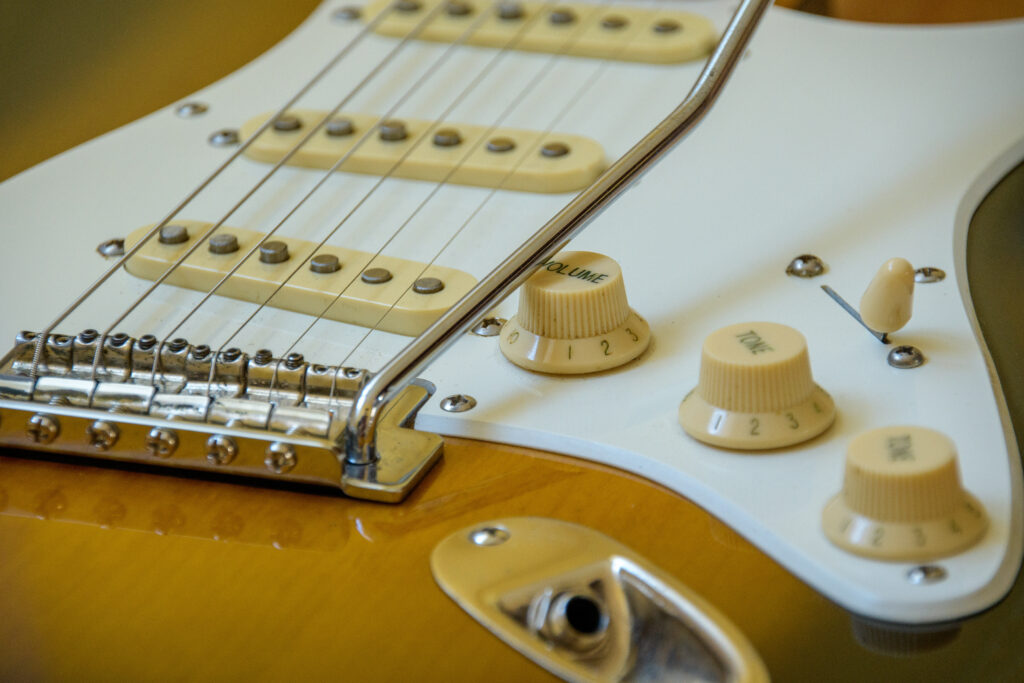
#2 – The Strat Didn’t Always Have a 5-way Selector
One of the Fender Stratocaster’s defining features is its 5-way pickup selector. This switch offers players five distinct tones, from the bright, cutting bridge pickup to the warm, articulate neck pickup.
When Leo Fender first unveiled the Stratocaster, it featured a 3-way pickup selector. The placement of the pickup selector allows guitarists to easily access it with their picking hand while playing.
The initial switching configuration allowed the use of individual pickups: the neck, the middle, or the bridge pickup. Towards the end of the 1950s, guitarists began to notice two additional positions that weren’t immediately accessible.
Stratocaster players discovered that by delicately balancing the switch in the two points between the three notched positions, they could achieve two unique tones. Position 2 combined the neck and middle pickups together and Position 4 combined the bridge and middle pickups.
These settings delivered a crisp and hollow tone that was the result of phase cancellation. These settings would become a favourite for many Strat fans and are a crucial part of its signature sound.
This unintended feature quickly gained popularity among guitarists, with many notable players showing a preference for these tones. Guitar legends, such as Mark Knopfler, Jimi Hendrix, Stevie Ray Vaughan, David Gilmour and Robert Cray, have notably exploited these “hidden” settings.
To cater to this trend, Fender officially introduced a five-way selector switch in 1977. This made switching to these preferred pickup combinations more stable and easier to access.
Jump Back To The Start
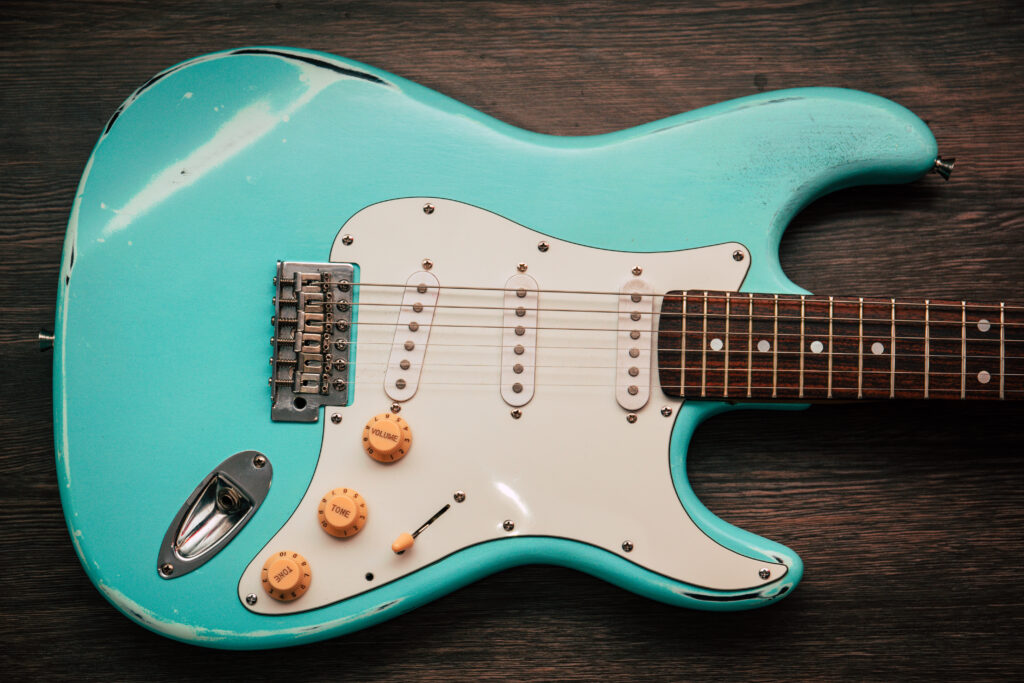
#3 – It Set a New Standard for Playing Comfort
While the Stratocaster borrowed several design elements from its predecessor, the Telecaster, its distinct shape and playability were revolutionary innovations.
Whilst popular, the Telecaster was less comfortable to play due to its squared-off body. It could dig into a guitarist’s body and forearm whilst playing.
Guitarist and Fender collaborator Rex Gallion suggested that a solid-body guitar didn’t need squared-off edges since it lacked an internal sound chamber, like an acoustic guitar. Inspired by this idea, Gallion asked Leo Fender, “Why not get away from a body that is always digging into your ribs?”
In response to this feedback, Fender took a different approach with the Stratocaster, ensuring the design would improve upon the comfort issues noted in its predecessor.
This led to the development of a guitar with rounded edges and deep body and forearm contours, enhancing player comfort and adding to the Stratocaster’s sleek aesthetic.
The process of refining the Stratocaster’s shape began in early 1953 when its body shape still closely resembled the Telecaster’s. However, by spring, Freddy Tavares, an esteemed multi-instrumentalist, session musician and engineer, sketched out a new body design.
Tavares adapted Leo’s balanced two-horned shape from the Precision Bass, fusing it with elements of the Telecaster to create something entirely new. The Stratocaster thus emerged as a unique instrument, embodying features of Fender’s first two instruments of the 1950s.
Jump Back To The Start
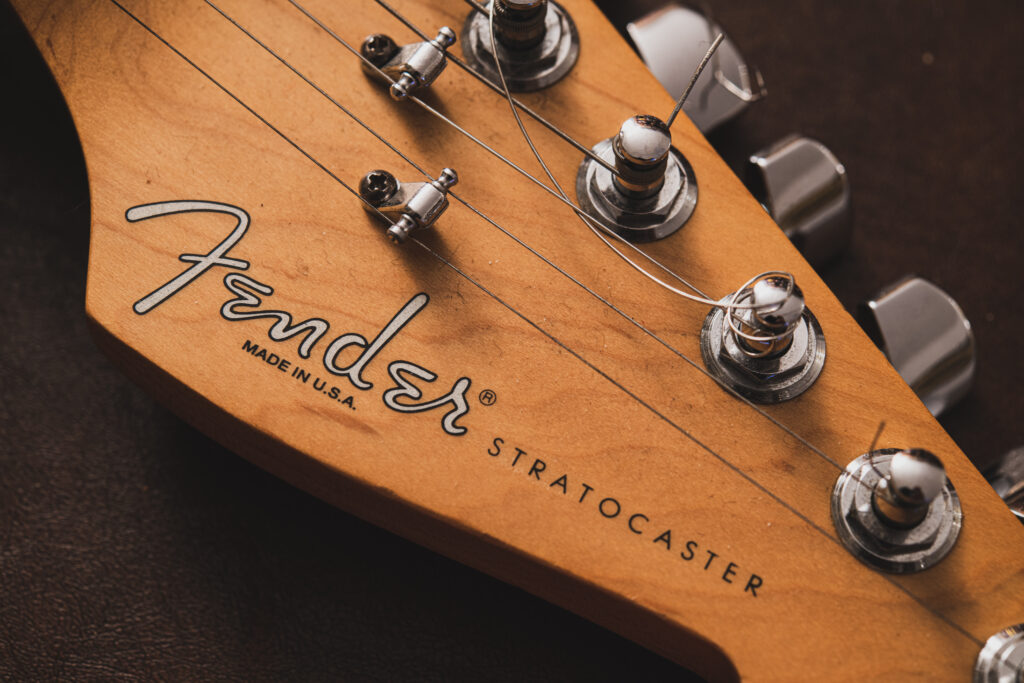
#4 – Leo Fender Didn’t Coin Its Name
As early as 1952, Leo Fender, a legendary figure in instrument making, had already made significant strides in shaping the music industry with the development of the Telecaster and the Precision Bass. The Tele and the P-Bass alone are two of the most important in the world of electric instruments.
Fender’s next solid-body guitar project was well underway when Don Randall, Fender’s marketing virtuoso, bestowed upon it a name that would forever echo in the annals of guitar history: the Stratocaster.
The Stratocaster was the fruit of collaboration between Leo Fender and his team. Thanks to the input of people such as Freddie Tavares and Don Randall, the Strat was created with a truly innovative flair that set it apart from other electric guitars.
Don Randall’s well-known affinity for aviation suggests that he named the guitar “Stratocaster” as a tribute to the marvels of aircraft technology.
This unique connection melded together the worlds of music and aviation, imparting a sense of speed, innovation and cutting-edge design that the Stratocaster guitar truly embodied.
In retrospect, the naming seems prophetic, as the Stratocaster went on to soar in popularity and become an iconic instrument in its own right.
Jump Back To The Start
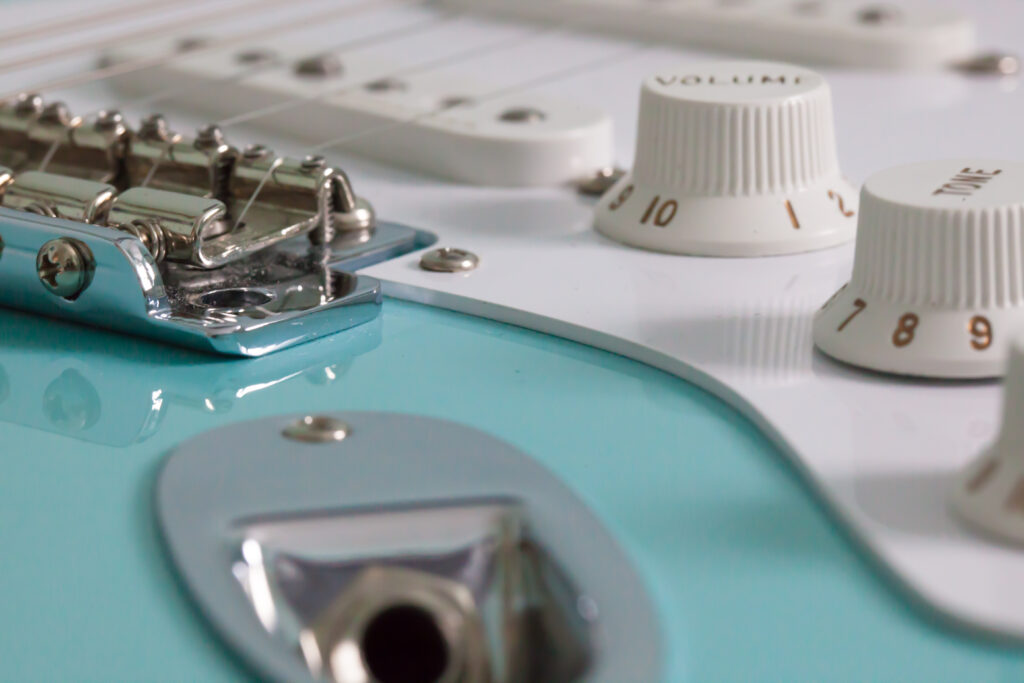
#5 – The Stratocaster Was the First Fender With a Sunburst Finish
In a move that marked another significant first for Fender, the development of the Stratocaster introduced the use of a sunburst finish on the brand’s guitars. Don Randall, a manager at Fender in its early years, insisted on this as he wanted to give the guitar a premium aesthetic.
The sunburst finish incorporated two prevalent paint hues of the time: a deep, brownish-black outer shade named “Dark Salem”, which gradually transitioned to a radiant, inner golden tone called “Canary Yellow”.
This tasteful finish had a practical advantage too. It also effectively masked any mismatches in the wood grain of the ash bodies. The construction of guitar bodies typically involved glueing together two or more pieces, which could occasionally result in inconsistencies in the wood grain pattern.
The sunburst finish, however, subtly lessened the visibility of such mismatches, thereby presenting a cohesive, high-end look that accentuated the Stratocaster’s retro-futuristic charm.
Jump Back To The Start

#6 – It Was the First Fender Guitar Offered with Custom Colours
Back in the 1950s, Fender offered the Stratocaster as their first electric guitar with a custom finish. Initially, a sunburst finish was standard from its inception in 1954. However, during this time, the craftsmen created a few custom-coloured guitars specifically for certain artists.
Fender presented Eldon Shamblin of the Texas Playboys with a golden Stratocaster, while Bill Carson and Pee Wee Crayton received models in a solid red colour. Fender would later recognize this particular shade of finish as “Dakota Red.”
The birth of what we now know as Fender’s first “official” custom colour happened around 1957, courtesy of George Fullerton, a long-time Fender collaborator.
Fullerton created a vibrantly hued Stratocaster in a colour now universally recognized as “Fiesta Red”. Following this vibrant addition, a broader array of custom colours became available for customers willing to pay an additional fee.
The crafting process for these custom colour guitars was intricate, involving varying preparations, colour coats, clear coats and more, depending on the body wood and other factors.
The 1958-1959 Fender catalogue was the first to proudly display a full-colour photograph of a custom-coloured Stratocaster, showcasing a dazzling red model adorned with gold hardware.
Jump Back To The Start
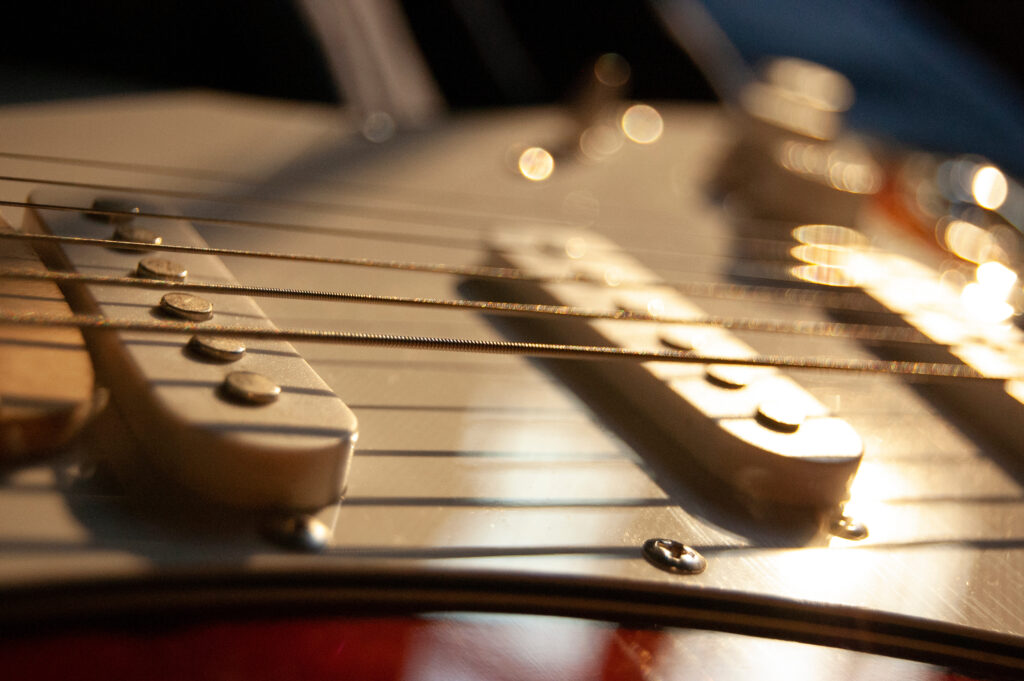
#7 – Hank Marvin Received the First Stratocaster in the UK
In the late 1950s, young British guitarists faced a significant barrier: a post-World War II import trade ban on US goods made acquiring a Fender instrument exceedingly difficult.
This posed a particular disappointment for one young London guitarist, Brian Rankin, better known by his stage name, Hank Marvin. A new recruit in singer Cliff Richard’s band, Marvin only had a modest Japanese electric guitar to his name.
Marvin’s longing for a Stratocaster was sparked by seeing Buddy Holly clutch one on the cover of the 1957 album The “Chirping” Crickets. Despite the trade ban, Cliff Richard offered to secure a Stratocaster for Marvin, an offer the young guitarist leapt at.
In early 1959, a gleaming, brand-new Fiesta Red Stratocaster, complete with gold hardware, miraculously found its way to London.
This was reportedly the first Fender Stratocaster to enter the UK. Armed with this iconic instrument and as a part of The Shadows, Hank Marvin ascended to stardom, becoming one of Britain’s first guitar heroes.
Jump Back To The Start

#8 – The First Strat Bridge Design Was a Failure
The Stratocaster’s most profound innovation lay in its bridge. In an attempt to address feedback from Telecaster players, Don Randall, Fender’s sales and marketing virtuoso, proposed that the new guitar should feature some kind of vibrato system.
Eager to outshine the designs of his ex-business partner, Doc Kauffman and contemporary, Paul Bigsby, Leo Fender took up this challenge with his characteristic determination.
However, the original design for the Stratocaster’s vibrato bridge fell decidedly short of the mark. In a somewhat out-of-character move, Leo prematurely equipped his factory to produce this system before thorough testing.
The initial system, misnamed as a “tremolo” by Fender, involved a bridge with rollers for each string and a separate tailpiece. In this design, the strings physically moved over the bridge via the rollers. This initial Strat bridge design is similar to what would be used for the Jazzmaster and Jaguar.
Although Leo and guitarist/advisor Bill Carson deemed the prototype satisfactory during factory trials, the system faltered under real-world conditions. Even Carson admitted that it “sounded like an amplified banjo with no sustain” when used in a live gig.
A New Design
Leo, not deterred by this setback, dedicated considerable time and resources to perfecting this system well into 1953. Unfortunately, the design had to be discarded entirely and restarted from scratch.
This delay caused much frustration within the sales team who wanted to get the Strat onto the market as soon as possible. Pressure mounted on Leo to conceive a new Stratocaster vibrato system.
Taking inspiration from a gram scale, Leo devised a revolutionary new design in late 1953. This concept involved the entire bridge assembly moving with the strings instead of the strings moving over stationary rollers.
The strings were loaded through a cavity routed into the guitar’s back, passing through a solid steel “inertia block” attached to the underside of the bridge plate. This block helped to enhance the Stratocaster’s sustain.
The back of the bridge plate was unanchored and slightly elevated. The front was fixed to the guitar body with six screws, one in front of each bridge saddle. The bridge could be rocked back and forth, altering pitch, with an easily detachable “tremolo” arm.
The system was held in a state of equilibrium, allowing guitarists to embellish their notes and chords with vibrato.
The Stratocaster was eventually launched in the spring of 1954 as Fender’s new flagship guitar, available in both tremolo and non-tremolo models.
Jump Back To The Start
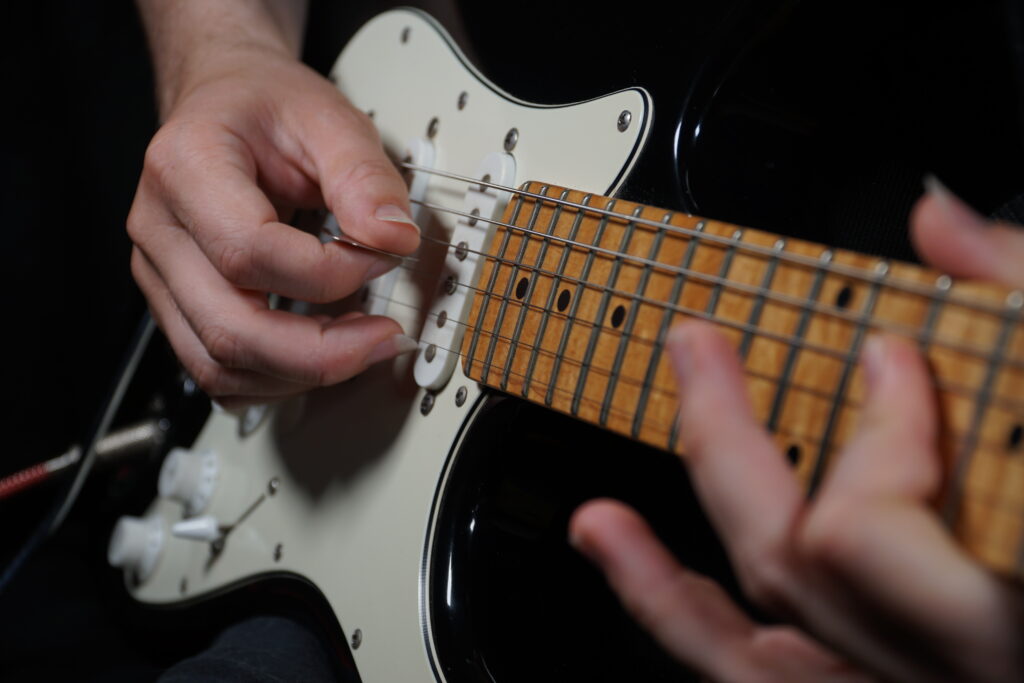
#9 – It Wasn’t an Immediate Success
The Stratocaster, an innovative instrument of its time, wasn’t an overnight sensation. In fact, its journey to popularity was more of a marathon than a sprint.
When introduced in 1954, it was still relatively unknown three years later. Many professional guitarists of the era found the novel Fender to be off-putting. The Strat was a far cry from the traditional guitars of the time.
With how entrenched the Strat is in the world of electric guitar, it’s hard to imagine it as being unconventional and too extreme for many players. But it certainly was when it was first released.
In the mid-1950s landscape, rock ‘n’ roll was gradually gaining national momentum. However, the lead instruments were predominantly saxophone and piano. Those early rock ‘n’ roll pioneers who did adopt the guitar generally favoured flat-top acoustics or large, hollow electrics crafted by Gibson and Gretsch.
During these formative years, the Stratocaster quietly held its ground. As the saxophone and piano gradually made way for the more powerful sound of the electric guitar, Fender saw an opportunity. They placed their pioneering Stratocaster in the capable hands of Western swing and pop guitarists.
Among them were the likes of Buddy Merrill from Lawrence Welk’s band, Alvino Rey, Eddie Cletro, Charlie Aldrich, Al Myers, “Stash” Clements, Kenneth “Thumbs” Carllile, Charley Raye and others.
Simultaneously, Leo Fender and his team didn’t rest on their laurels. They committed to refining the Stratocaster, persistently tweaking and improving it. By 1957, their efforts culminated in a nearly perfect design that has remained largely untouched to this day.
The Stratocaster, while initially misunderstood, gradually became a best-selling instrument. It proved as more than a fleeting gimmick. Instead, it would be recognised for its innovative design, comfortable playability and sonic versatility.
Jump Back To The Start
Final Thoughts
In the years since its slow and steady ascent to prominence, the Fender Stratocaster has found itself in the hands of some of the most influential musicians in the world.
It has become an integral part of the soundtracks of countless music fans. It has become a symbol of a musical revolution, its iconic shape and sound emblematic of rock ‘n’ roll itself.
From the fiery and innovative riffs of Jimi Hendrix to the melodic brilliance of Eric Johnson; from the raw blues power of Buddy Guy to the experimental and versatile genius of Jeff Beck – each of these musicians has left an indelible mark on the music world with a Stratocaster by their side.
Today, the Stratocaster continues to inspire generations of musicians, who, much like Hendrix, Johnson, Guy, Beck and so many others, seek to express themselves through its strings.
Despite its slow start, the Stratocaster has become more than just a guitar; it’s a testament to innovation, resilience and the transformative power of music.
In the end, the Stratocaster isn’t just a guitar that has withstood the test of time; it’s a timeless instrument that continues to shape the sound of music, embodying the spirit of rock ‘n’ roll in every note that it brings to life.
From its humble beginnings in the 1950s to its iconic status today, the Stratocaster’s story is a resounding testament to the enduring power of Fender’s creativity and innovation.
Ready to be a part of the Stratocaster legacy? Click here to shop our range of Fender and Squier Stratocasters.